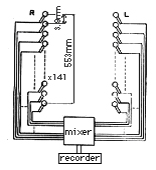It may sound contrary, but if you take this error into account, 16bit without oversampling is more accurate than 8x-oversampling/20bit.

[daiagram7]
in case SM5815A
is used in 1/2 decimation |
The diagram 7 indicates the diaphragm 5 replaced with a recording hardware. If you ever felt the digital recording somewhat lacking a core of the sound, please examine this illustration carefully. In a way, one point recording using digital filter is so much nonsense. The time will come in the near future when the performance of a digital filter will be evaluated not only by its cut-off characteristics but also how small a number of taps it has. If the digital filter is a necessary evil, we have to make sure to limit the total delay within 2ms throughout the recording and playback so that it won't be caught by human auditory sense. |
The Sound of Non-oversampling
We can control the "diffusion of sound coherence" only by constructing it with smaller number of taps. From that aspect, Wadia's decoding computer (13 taps) or Luxman's former fluency DAC, DA-07 (3 taps) are considered to be excellent machines. They both received (Wadia still does) outstanding appraisals at the time for their sensual representation of the sound. The sound of non-oversampling DAC is on the extension of these machines, and theoretically, it can exceed those achievements.
The difference between the non-oversampling DAC and the conventional DAC with the digital filter lies whether you attach importance on the accuracy in the time domain or in the frequency domain. In other words, whether you choose the musical performance or the quality of a sound. This trade-off line defines the boundary of the current digital audio format .
A natural, stress-free sound that communicates the musicians' intention directly to you. That is the sound of non-oversampling DAC. The feel of this sound is closer to that of analog reproduction.
Introducing Non-PLL clock
We can still hear the characteristics of each different transport even after lowering the jitter sensitivity to a minimum by non-oversampling. This is an incomplete section of today's digital audio format. The fundamental advantage of being digital, that its quality does not depend on the conveying form, falls completely short here. That is because we have to create the time axis from the incoming data by PLL at the receiving end. This is a flow inevitable to the current DAI format which requires word-synchronization. It is often misunderstood as if the time axis is digital, instead of analog, because it receives discrete value after sampling, but actually, it is completely analog. When the time axis is distorted, the analog wave form is distorted with it.
Then what is going to happen if we read it by its own clock at the receiving side? Unfortunately, the word-synch can not be kept and the waveform will be broken into shreds. I tried to re-clock it with a separate non-PLL-clock after once it's locked with PLL and reproduced (diagram 8). By doing this, the fluctuations within 1 clock of the PLL are completely absorbed and not transferred to the reproduced waveform. But any fluctuations beyond 1 clock, even if it'[s only 1ps, are magnified into that of 1 clock. This happens often, because of the frequency difference between the PLL clock and non-PLL clock. In case of this 50MHz non-PLL clock, the amount is 20ns per every 0.1ms. This is, after all, more than 100 times of the 16bit criterion.

1. Non-PLL clocl 50MHz
2. PLL clock 2.8224MHz(44.1kHz x 64fs)
3. re-clock pulse
[daiagram8]
Non-PLL re-clock
|
How does it sound? Are the notes broken or jumping around and unbearable to listen to? Somehow it does not, and not only that; it generates an extremely realistic sound field. A certain acoustic atmosphere envelops the room making you feel like you are on the same floor with the performers, communicating the tensions and relaxation among musicians to you. |


